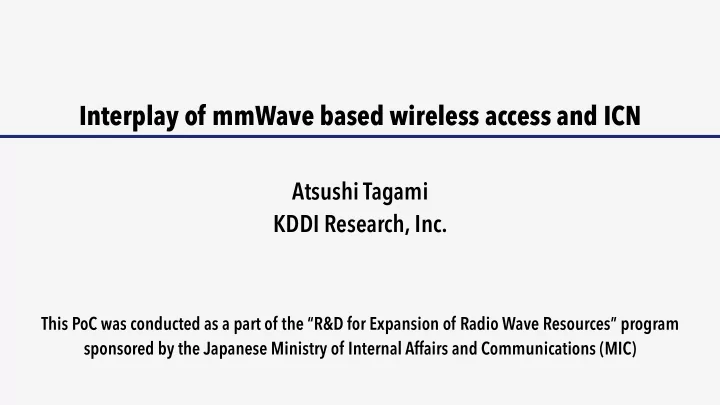

Interplay of mmWave based wireless access and ICN Atsushi Tagami KDDI Research, Inc. This PoC was conducted as a part of the “R&D for Expansion of Radio Wave Resources” program sponsored by the Japanese Ministry of Internal Affairs and Communications (MIC)
IMT2020 Features 2 • Higher frequency bands are allocated for mobile services • CAN provide wide bandwidth (1Gbps - ) • CANNOT provide wide coverage area (less than tens meter) • Mobile Edge Computing provides a storage at an edge device Lower Freq. Higher Freq.
Heterogeneous Network 3 • Higher frequency bands leads Heterogeneous network • Future mobile network consists of • Macro Network provides a wide coverage area • Spotty Networks provide small coverage areas Lower Freq. Higher Freq. Spotty Network Macro Network
Spotty Network : Small Area 4 • Advantage • A user can monopolize a high-speed wireless link since the number of users in the same area is very small • Disadvantage • A user passes through the small area in a very short time Spotty Network Macro Network
Spotty Network : High Speed Link 5 • Advantage • Transferring a large amount of data in a short time • Disadvantage • The backhaul network can be the bottleneck Spotty Network
Concept of mmWave based Wireless Access Network 6 • Leveraging the storage of each device • Prefetching content into base station on spotty network • Caching content on mobile device • Providing content from cache Spotty Network
Experiment of mmWave based Wireless Access Network 7 • We developed a 40GHz and 60GHz wave-based access network Wi-Fi AP Cloud / Server (Macro Network) 40GHz bands / 1Gbps 60GHz GATE / 6.1Gbps (Nano Network)
Techical Problem for mmWave based Access Network 9 • Current Internet technology is based on an end-to-end “connection” • Need to establish a connection between a client and a server • Need to keep the connection for the continuous service • End-to-end based congestion control SYNACK SYN ACK
Benefits of Information-centric Networking 10 • Information-centric paradigm can solve them natively • Users are primarily interested in content/information • and NOT from where and how they get the content
Features of Information-centric Networking 11 • ICN is suitable to develop this content delivery scheme • Name the data • Every piece of network data is named • Transfer the data • the data is transferred to interested recipients • Secure the data • every piece of network data is secured
Name the data 12 • Content is separated into small pieces and every piece is named • Network can know which pieces are downloaded • Network can decide which pieces are prefetched Content#1/1 Content#1/2 Content#1/3 Content#1 Content#1/4 Interest : Content#1/1 Content#1/5 Interest : Content#1/2 Content#1/6 Content#1/7
Transfer the data 13 • Network forces on only data transferring, • It is not unaware from where to get it • Also the same even a cache on the mobile terminal Content#1/1 Content#1/3 Content#1/2 Interest : Content#1/3 Interest : Content#1/6 Content#1/4 Content#1/5 Interest : Content#1/4 Interest : Content#1/7 Content#1/6 Interest : Content#1/5 Content#1/7
Transfer the data 14 • Network forces on only data transferring, • It is not unaware how to transfer it • It is easy to aggregate the different transmissions burst congestion-controlled Content#1/1 Content#1/2 Content#1/3 Content#1/4 Content#1/5 Content#1/6 Content#1/7
Secure the data 15 • Each piece has signature of publisher and is encrypted • A user can trust downloaded content without certification of spotty network ✓ Content#1/1 ✓ Content#1/2 ✓ Content#1/3 ✓ Content#1/4 ✓ Content#1/5 ✓ Content#1/6 ✓ Content#1/7
Conclusion 17 • Interplay of mmWave based wireless access and ICN • to avoid disadvantages of mmWave bands • Small coverage area • to leverage benefits of mmWave / IMT-2020 • Diversity of access networks • Storage at edge/end devices • We showed an application of mmWave and ICN for IMT-2020
Recommend
More recommend